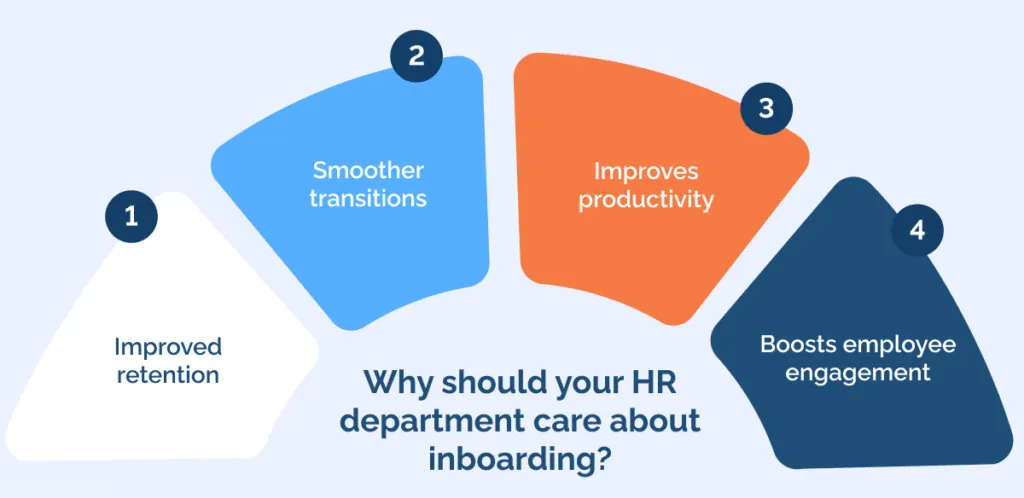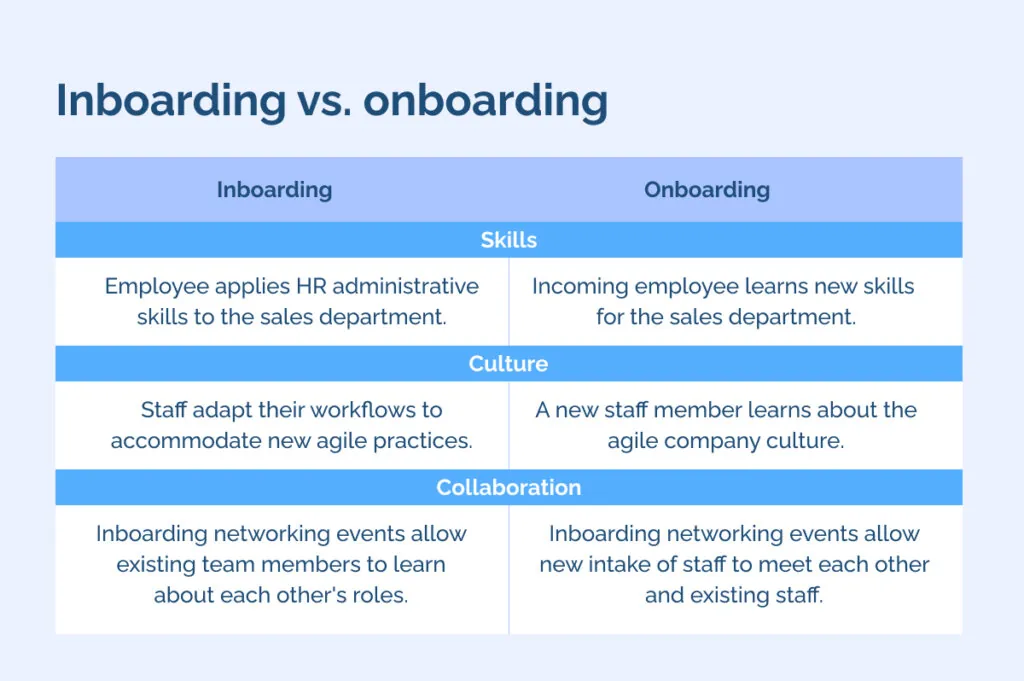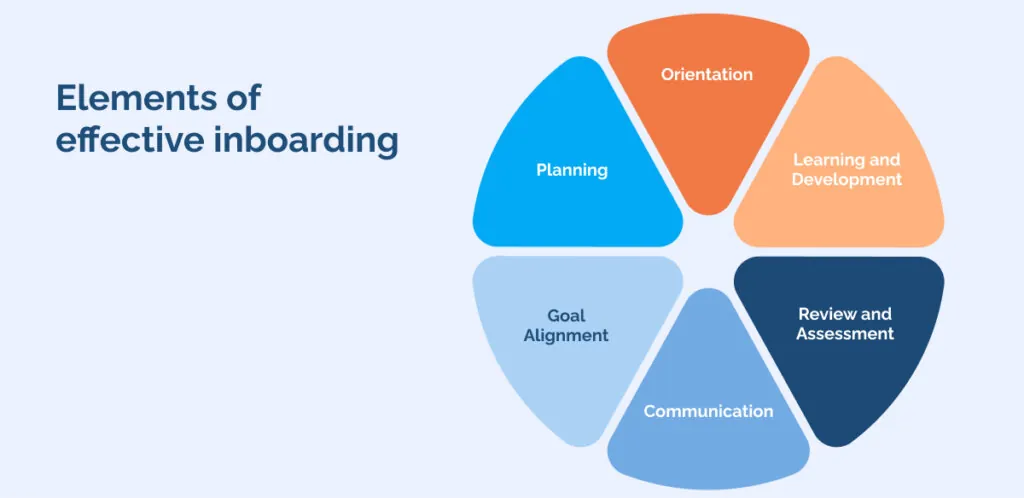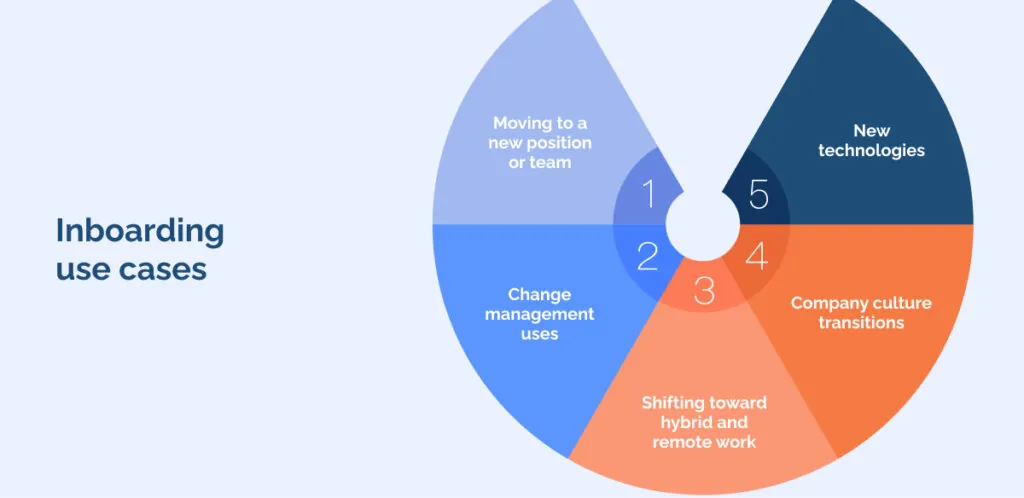
HR leaders often discuss the best practices for welcoming new team members to the organization, but it’s also essential to consider the best practices for internal staff movement.
Organizations often overlook inboarding, but doing so is a missed opportunity, as it can ensure employee retention remains high. It can also positively impact employee productivity as staff are more satisfied and show higher productivity when they receive support during promotion or movement to an office in a new country or region.
17% of employees depart their company after 3 months, and inboarding may help reduce this number as employees feel they will receive support to progress upwards or change roles or locations.
This article will explore inboarding, encompassing its definition, the relevance of inboarding for HR departments, a comparison between inboarding and onboarding, and the six key elements contributing to effective inboarding.
What does inboarding mean?
Inboarding means the continual HR process for equipping existing employees with the knowledge, skills, and training necessary for success within an organization as they move from one department or national office to another.
While its essence aligns with onboarding, inboarding targets established staff rather than new hires; the primary goal is to enhance time-to-productivity, foster engagement, and bolster retention.
Some inboarding scenarios include:
- Returning from maternity leave.
- Transitioning to a higher position vertically.
- Making a horizontal job role move (sales to HR administrator).
- Moving from a US to a Canada office in the same company.
Why should your HR department care about inboarding?

There are four reasons why your HR department should care about inboarding, starting with improved retention.
1. Improved retention
Inboarding offers the support and sense of community essential for retaining employees. In today’s economy, a lack of fulfillment prompts departures, and it is so common that 3.7 million US workers left their employers alone in October 2023, which was typical for that year.
This statistic shows that hiring is not enough, but it is essential to retain the right staff to avoid waste and maintain business success.
Departures negatively impact businesses financially and productively, and backing employees through L&D initiatives, including inboarding, optimizing employee experience and engagement, fostering their commitment to stay and help their organization thrive.
A successful employee training program nurtures an environment where employees feel connected to the organization’s mission, valued, and driven to pursue career goals within the company. Lower recruitment costs and workflow continuity result from reduced employee turnover.
2. Smoother transitions
A well-organized inboarding process enables employees to transition into new roles and navigate organizational changes seamlessly. The plan outlines precise job descriptions, expectations, daily tasks, future goals, and straightforward transition procedures.
This action ensures employees don’t feel abandoned to figure things out independently, fostering confidence and enthusiasm to move forward. Implementing a meticulously structured inboarding plan, coupled with ample support, swiftly enhances employees’ comfort and productivity in new situations.
3. Improves productivity
Implementing effective L&D initiatives, including inboarding programs, helps employees acclimate quickly to new responsibilities and internal change so they can hit the ground running. 87% of L&D professionals also agree that learning and development must focus on improving employee experience, which boosts retention.
Inboarding also shows an organization’s commitment to investing in employees’ career development and overall well-being. This level of investment promotes employee experience, leading employees to become more productive and committed to high-quality work.
4. Boosts employee engagement
Employees who receive the support they need to perform their duties are more satisfied and engaged. However, companies are not doing enough to engage their employees, as employee engagement showed less than a third of employees (31%) felt engaged in 2023. This statistic shows a 2% drop from the year before.
A strong inboarding program provides employees transitioning into new roles and working environments with clear expectations, proper training and feedback, and incorporating personal career goals to maintain an engaging and supportive environment.
Inboarding vs. onboarding

On the surface, onboarding and onboarding appear similar, equipping employees with skills for success in new roles. Structurally similar, inboarding mirrors onboarding with shared steps like knowledge transfer, shadowing, real-time training, and mentorship.
Yet, inboarding targets seasoned team members, enhancing their knowledge and skills for future organizational steps. Focused on cross-training, upskilling, and program awareness, it capitalizes on familiarity with company culture and operations.
In contrast, onboarding readies new employees for a journey in an entirely unfamiliar organization.
The differences between inboarding and onboarding become clearer if you view the examples below of how each works in practice.
Skills
Inboarding: Employee applies HR administrative skills to the sales department.
Inboarding: Incoming employee learns new skills for the sales department.
Culture
Inboarding: Staff adapt their workflows to accommodate new agile practices.
Inboarding: A new staff member learns about the agile company culture.
Collaboration
Inboarding: Inboarding networking events allow existing team members to learn about each other’s roles.
Inboarding: Inboarding networking events allow new intake of staff to meet each other and existing staff.
Elements of effective inboarding

Crafting inboarding programs involves tailoring them to the unique identity of each organization, but specific essential components must be part of the integration into an effective inboarding plan.
Planning
Before initiating the inboarding process, managers must thoroughly identify the team member’s learning requirements for a successful transition. Doing so involves discerning needs related to adopting new technology or adapting to change management.
Establishing clear roles and responsibilities and a well-defined inboarding transition plan is imperative for seamless integration into the evolving organizational landscape.
Orientation
While internal hires might grasp the organization’s broader objectives, inboarding necessitates a dedicated orientation phase.
Delivering an informative overview of new roles or organizational changes and essential insights into the working environment becomes vital. This foundational step ensures that internal hires have the knowledge to navigate and contribute effectively.
Learning and Development
Following orientation, employees immerse themselves in comprehensive training tailored to specific changes.
The chosen format should align with employees ‘ diverse learning needs, whether through eLearning, on-the-job training, or traditional classroom lessons. This dynamic approach ensures a robust foundation for adapting to new responsibilities and internal changes swiftly and efficiently.
Review and Assessment
Continuous feedback opportunities during and after training sessions empower employees and managers to gauge progress and identify additional needs.
Ongoing support facilitates a smooth integration into new roles or organizational changes. Regular assessments foster a culture of improvement and responsiveness to evolving requirements.
Communication
Establishing precise and efficient communication channels is paramount for inboarding success. Providing employees with consistent information about expectations and offering timely feedback from managers creates an environment where obstacles can be openly communicated and addressed.
Effective communication enhances transparency and cultivates a collaborative and supportive atmosphere.
Goal Alignment
Inboarding programs must seamlessly align with the organization’s overarching values and goals. This alignment provides employees with a clear understanding of their role in the broader organizational context, fostering a sense of purpose.
This heightened purpose enhances day-to-day activities, contributing significantly to heightened employee engagement and commitment.
Inboarding use cases

As employees progress within an organization and the organizations themselves change, employers can facilitate smooth transitions for their team members through inboarding. Here are some notable inboarding scenarios crucial for organizations:
Moving to a new position or team
Inboarding becomes a crucial support system when employees transition to different roles or switch departments. It facilitates their adaptation to the new work environment, ensuring they navigate the change smoothly and acquire the essential skills vital for success in their evolving roles.
Change management uses
Organizational changes often induce stress and disruption in the workforce. Integrating inboarding into the change management process helps keep employees engaged during challenging transitions and equips them with the skills needed to embrace the future.
Shifting toward hybrid and remote work
During the shift to remote or hybrid working models, inboarding establishes a vital foundation through remote training and continuous communication, providing essential support.
Digital adoption platforms prove invaluable, offering in-app guidance through various formats like step-by-step walk-throughs, balloon tips, videos, and written guides, ensuring efficient adaptation to new work environments.
Company culture transitions
Cultural shifts alter the foundation of employees’ connection with the company. Inboarding becomes essential for introducing current employees to the new vision and core values, maintaining high engagement and productivity.
New technologies
With new software and technologies, inboarding becomes crucial for helping team members swiftly adapt. Digital adoption platforms play a significant role by guiding enterprise applications through diverse formats, tracking progress, and collecting valuable feedback.
Other technologies which can support inboarding practices include:
- IntranetHR system.
- Video conferencing technology.
- Learning management system (LMS).
- Communication and collaboration tools (Zoom, MS Teams).
Investing in digital technologies like a digital adoption platform efficiently manages tech changes. DAPs support inboarding with in-app guidance, tracking progress, and gathering feedback, ensuring a smooth transition during change initiatives as your staff learn to use apps without disrupting their workflow.
Adopt inboarding practices to promote internal agility
Empower your organization’s transformative growth by embracing agile inboarding practices recognizing the broad and far-reaching benefits.
HR managers play a pivotal role in fostering internal agility by strategically implementing inboarding tailored to organizational shifts, role changes, and promotions. This proactive approach ensures seamless transitions and enables employees to adapt swiftly, ultimately enhancing efficiency, engagement, and retention.
Prioritize dynamic workplace culture by aligning inboarding practices with evolving organizational needs and goals. Integrate inboarding into your organizational culture today, making change a key driver of success with the dedicated involvement of HR.
Tristan Ovington
Tristan Ovington is a professional senior writer and journalist, specializing in providing expert insights on various topics such as digital adoption, digital transformation, change management, and Cloud apps. He delivers his knowledge through accessible online content that is data-driven and presented in a friendly tone, making it easy for readers to understand and implement.



